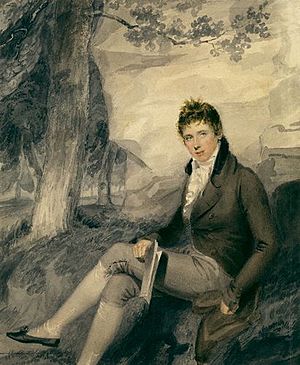Thomas Heaphy facts for kids
Thomas Heaphy the Elder (born 1775, died 1835) was a talented British artist. He was especially known for his beautiful watercolour paintings and for drawing amazing portraits of people.
The Artist's Life
Thomas Heaphy was born in London on December 29, 1775. His father, John Gerrard Heaphy, was a merchant with Irish roots, and his mother was French. When he was young, Thomas became an apprentice to R. M. Meadows, an engraver. An engraver is someone who carves designs onto metal plates to make prints. Thomas also went to a drawing school run by John Boyne.
Heaphy became a very successful painter. He used a lot of his money to help develop land near what is now Regent's Park and a part of St. John's Wood in London. This work took him away from painting for a while.
Later, he helped start the Society of British Artists. This was a group for artists to show their work. Heaphy was chosen as its first president. In 1824, he showed nine of his paintings at the society's first exhibition. However, he left the group the next year.
In 1831, Heaphy traveled to Italy. He stayed there for about a year, making copies of famous paintings by old master artists. After he returned to England, he didn't paint as much.
Thomas Heaphy passed away on October 23, 1835, at his home in St. John's Wood Road. He was buried in Bunhill Fields.
His Art and Famous Works
Heaphy first showed his art at the Royal Academy in 1797. Until 1804, he mainly showed portraits. But that year, he sent a different kind of painting called The Portland Fish Girl.
After this, he started focusing on water-colour painting. He became a frequent contributor to the exhibitions of the new Royal Watercolour Society. His paintings of fish markets and other scenes of everyday working-class life were very popular. In 1807, he became a full member of the society. His painting Hastings Fish Market, shown in 1809, sold for a lot of money.
Heaphy then returned to painting portraits and was very good at it. He became the portrait painter for the Princess of Wales. Many important people, like Princess Charlotte and Prince Leopold, had him paint their pictures.
In 1812, Heaphy left the Water-colour Society. He went to Spain at the invitation of the Duke of Wellington. The Duke was leading the British army in the Peninsular War at the time. Heaphy painted portraits of the army officers there.
When he returned to England, he created his most important work. This was a large painting showing the Duke of Wellington giving orders before a big battle. It included portraits of about fifty generals. Heaphy later published an engraving of this painting in 1822. The king had asked for this painting, but it seems to have stayed with Heaphy until his death.
Even though some thought he didn't like the Royal Academy, Heaphy continued to show his art there until the end of his life. The South Kensington Museum owns two of his water-colours: The Sore Leg and Coast Scene with Figures. The National Portrait Gallery, London has a portrait he painted of a young Lord Palmerston, who later became a Prime Minister.
His Family
Thomas Heaphy married his first wife, Mary Stevenson, in 1800. She passed away sometime after 1820. His second wife, Harriet Jane Mason, lived longer than he did.
Heaphy had two sons with his first wife, Thomas the younger and Charles Heaphy. He also had three daughters. Two of his daughters, Mary Ann (whose married name was Musgrave) and Elizabeth (whose married name was Murray), also became miniature painters.


